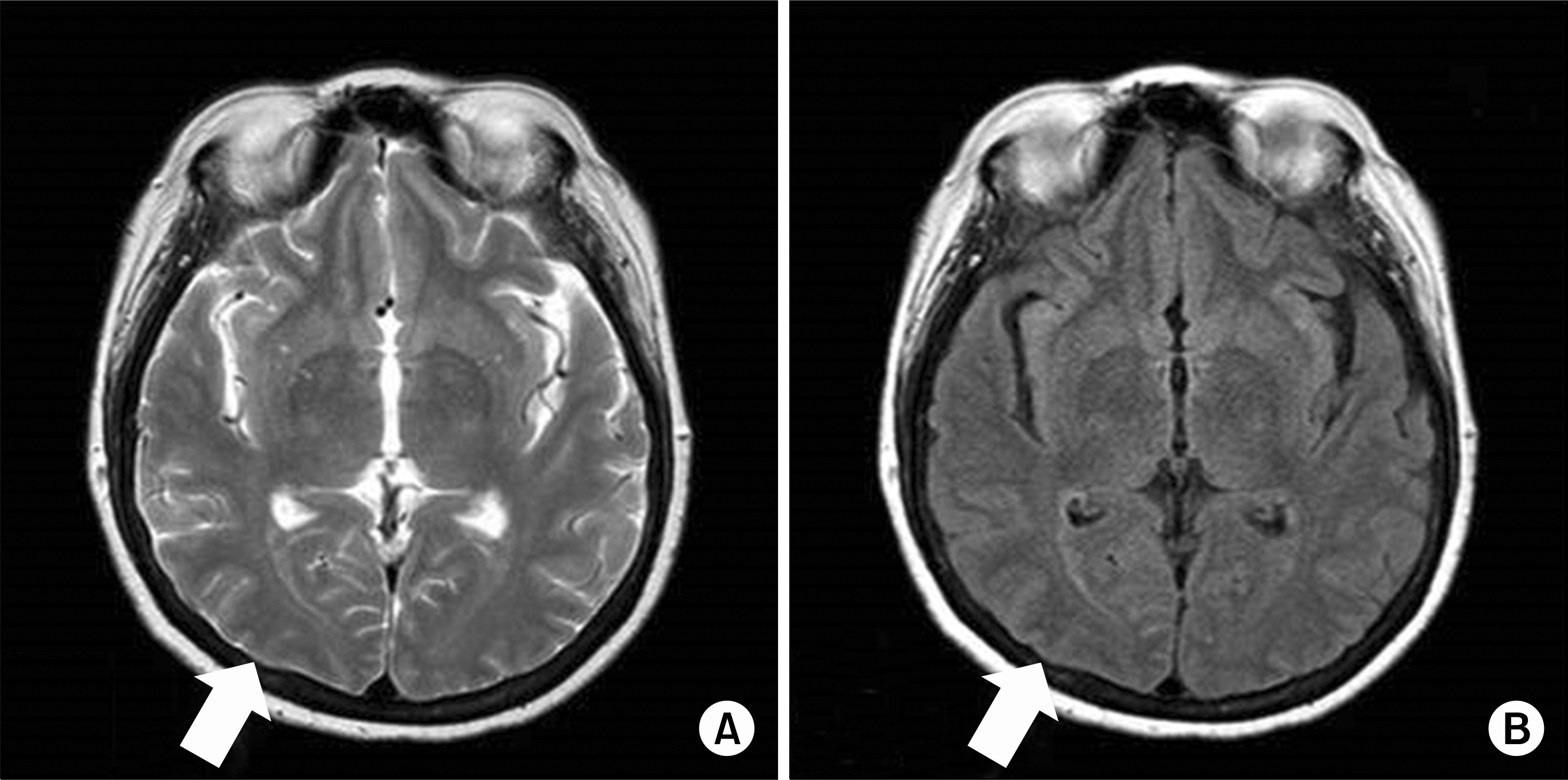J Korean Soc Transplant.
2015 Sep;29(3):166-169. 10.4285/jkstn.2015.29.3.166.
Posterior Reversible Encephalopathy Syndrome Improved by Changing Immunosuppressant from Calcineurin Inhibitor to Sirolimus in a Kidney Transplantation Recipient
- Affiliations
-
- 1Department of Internal Medicine, Inje University Busan Paik Hospital, Inje University College of Medicine, Busan, Korea. yeonghnl@inje.ac.kr
- KMID: 2202589
- DOI: http://doi.org/10.4285/jkstn.2015.29.3.166
Abstract
- Posterior reversible encephalopathy syndrome (PRES) is neurotoxicity characterized by brain imaging findings of reversible subcortical vasogenic edema. Clinical manifestations include seizure, altered mental status, focal neurologic deficit, and headache. Tacrolimus, a potent immunosuppressant, is related to increased risk of PRES in transplantation recipients. We report on a case of PRES in a 48-year-old female kidney transplantation recipient who received immunosuppression with tacrolimus, mycophenolate mofetil, and prednisolone. On postoperative day 14, she complained of moderate to severe headache which did not respond to usual analgesics. Magnetic resonance imaging showed high signal intensity on T2-weighted images and fluid-attenuated inverse recovery imaging in both parieto-occipital areas. The condition was improved after changing immunosuppressant from tacrolimus to sirolimus.
Keyword
MeSH Terms
Figure
Cited by 1 articles
-
Calcineurin Inhibitor Induced Multiple Infarctions
Hae-Bong Jeong, Jeong-Min Kim, Il-Han Yu, Jae-Han Bae, Oh-Sang Kwon, Kwang-Yeol Park
J Korean Soc Transplant. 2016;30(4):190-193. doi: 10.4285/jkstn.2016.30.4.190.
Reference
-
References
1). Hinchey J, Chaves C, Appignani B, Breen J, Pao L, Wang A, et al. A reversible posterior leukoencephalopathy syndrome. N Engl J Med. 1996; 334:494–500.
Article2). Bartynski WS. Posterior reversible encephalopathy syndrome, part 1: fundamental imaging and clinical features. AJNR Am J Neuroradiol. 2008; 29:1036–42.
Article3). Bartynski WS, Tan HP, Boardman JF, Shapiro R, Marsh JW. Posterior reversible encephalopathy syndrome after solid organ transplantation. AJNR Am J Neuroradiol. 2008; 29:924–30.
Article4). Wong R, Beguelin GZ, de Lima M, Giralt SA, Hosing C, Ippoliti C, et al. Tacrolimus-associated posterior reversible encephalopathy syndrome after allogeneic haematopoietic stem cell transplantation. Br J Haematol. 2003; 122:128–34.
Article5). Wu Q, Marescaux C, Wolff V, Jeung MY, Kessler R, Lauer V, et al. Tacrolimus-associated posterior reversible encephalopathy syndrome after solid organ transplantation. Eur Neurol. 2010; 64:169–77.
Article6). Hammerstrom AE, Howell J, Gulbis A, Rondon G, Champlin RE, Popat U. Tacrolimus-associated posterior reversible encephalopathy syndrome in hematopoietic allogeneic stem cell transplantation. Am J Hematol. 2013; 88:301–5.
Article7). Fugate JE, Claassen DO, Cloft HJ, Kallmes DF, Kozak OS, Rabinstein AA. Posterior reversible encephalopathy syndrome: associated clinical and radiologic findings. Mayo Clin Proc. 2010; 85:427–32.
Article8). Lee VH, Wijdicks EF, Manno EM, Rabinstein AA. Clinical spectrum of reversible posterior leukoencephalopathy syndrome. Arch Neurol. 2008; 65:205–10.
Article9). Singh N, Bonham A, Fukui M. Immunosuppressive-associated leukoencephalopathy in organ transplant recipients. Transplantation. 2000; 69:467–72.
Article10). Besenski N, Rumboldt Z, Emovon O, Nicholas J, Kini S, Milutinovic J, et al. Brain MR imaging abnormalities in kidney transplant recipients. AJNR Am J Neuroradiol. 2005; 26:2282–9.11). Rykken JB, McKinney AM. Posterior reversible encephalopathy syndrome. Semin Ultrasound CT MR. 2014; 35:118–35.
Article12). Bartynski WS. Posterior reversible encephalopathy syndrome, part 2: controversies surrounding pathophysiology of vasogenic edema. AJNR Am J Neuroradiol. 2008; 29:1043–9.
Article13). Moskowitz A, Nolan C, Lis E, Castro-Malaspina H, Perales MA. Posterior reversible encephalopathy syndrome due to sirolimus. Bone Marrow Transplant. 2007; 39:653–4.
Article14). Dzudie A, Boissonnat P, Roussoulieres A, Cakmak , Mosbah K, Bejui FT, et al. Cyclosporine-related posterior reversible encephalopathy syndrome after heart transplantation: should we withdraw or reduce cyclosporine?: case reports. Transplant Proc. 2009; 41:716–20.
Article15). Barbas AS, Rege AS, Castleberry AW, Gommer J, Ellis MJ, Brennan TV, et al. Posterior reversible encephalopathy syndrome independently associated with tacrolimus and sirolimus after multivisceral transplantation. Am J Transplant. 2013; 13:808–10.
Article16). Roth C, Ferbert A. The posterior reversible encephalopathy syndrome: what's certain, what's new? Pract Neurol. 2011; 11:136–44.
Article
- Full Text Links
- Actions
-
Cited
- CITED
-
- Close
- Share
- Similar articles
-
- A Case of Interstitial Pneumonitis Associated with Sirolimus Treatment in Renal Transplantation Recipient
- A Case of Squamous Cell Carcinoma in Nasal Cavity Treated with Conversion to Sirolimus in a Patient with Kidney Transplantation
- Allograft Immune Reaction of Kidney Transplantation Part 2. Immunosuppression and Methods to Assess Alloimmunity
- Clinical features and outcomes of posterior reversible encephalopathy syndrome after heart transplantation: a case series
- Proliferation Signal Inhibitors: Sirolimus and Everolimus



